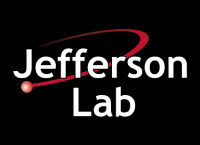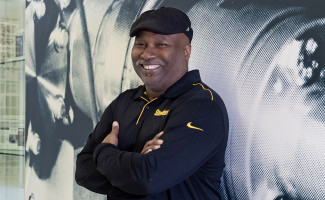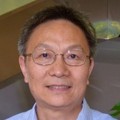Electronics Designer enthusiastically contributes to lab’s mission, knowledge pool
Marc McMullen has come a long way in understanding the work of the lab since he began his career in Hall B as a temporary employee “just pulling electrical cables” in 1996.
“I started out as your basic-level installation technician,” McMullen remembers. “We were building Hall B—the smallest and newest of the halls back then. I was hired as a temp. I was pulling cables and installing power supplies—and I didn’t know what a lot of it was that we were doing here at the lab. Back then I didn’t think about it.”
Now, McMullen is a senior instrumentation tech in the Detector Support group (DSG). He develops complex electronics systems for whatever is needed, be it a moisture sensor inside a machine or a functioning circuit board from scratch.
Once hired full time, McMullen committed himself to figuring out what, exactly, the lab produced.
“I started to wonder what we’re doing and I got interested in learning what I could do,” he said. “We don’t make things you can buy and hold, so there is no product to point to and say, ‘This is what we do.’”
To solve this riddle, McMullen turned his efforts toward asking more about the science to try to figure out how he could proactively support it.
“To get someplace, you have to absorb so much, and you have to have some value, and you want to know that the work that you do on a daily basis is important to the lab. So, I started to ask questions and learn everything I could. Now I’m the old guy who can share what I know—not in life, but at the lab,” McMullen laughs.
Working with his group, McMullen now helps to support all of the JLab experimental halls on projects of varying durations and complexities.
“We go beyond the scope of the physics division,” he explains. “We are also supporting the Electron-Ion Collider (EIC) that is being designed for Brookhaven National Laboratory. So, while there are specific spheres that our group covers, we aren’t limited from working on different projects.”
Finding new challenges
For McMullen, part of the joy he gets from his work at the lab comes from the opportunity each project gives him to tinker with new challenges while ensuring that each project is able to be completed safely.
“I wear a lot of hats and I have to do a lot of different things, including serving as the safety leader of the group,” he says.
As an electronics designer, McMullen is generally called in to advise scientists and their teams early in the process of designing an experiment. From there, McMullen is tasked with finding solutions to make the scientists’ experiments possible.
“Each project starts out with a concept in someone’s head,” he says. “We meet with the scientists to learn about what they need. From there, there are a few ways to come up with the design for equipment that will do what they need. Sometimes the design is brand new, sometimes it exists and you’re reviewing it for safety and making sure it still works with the equipment we have, and sometimes you’re making modifications to old equipment and designs.”
Reusing old equipment can save millions of dollars, depending on the equipment, and it is helpful if McMullen and his team find thorough documentation as they begin the process of redesigning it.
“As a designer, we have to be very good about documenting our work, as well, because it often happens that an experiment can reuse equipment that has already been made or used—and it is helpful to have documentation available for current scientists as well as future scientists who may need to recycle parts.
“For example, on one project, we wanted to reuse the constant current source board, which is derived from an old circuit board from a previous detector that is so old nobody really knows where the documentation is. We had a board and we didn’t have the documentation so we had to study it carefully and work backwards to create the documentation on how it is put together.”
From temporary employee to senior designer
McMullen also admits to finding tremendous value in his position as one of the lab’s longest-standing employees.
“I’ve learned that, essentially, to get someplace, you have to absorb so much through experience and learning,” he says. “As an employee, you have to add some value to your workplace. You want to know that the work that you do on a daily basis is important to the lab.”
As the self-described “old guy,” McMullen appreciates the value that his decades of experience bring to the team. Just as he relied on those more experienced engineers, scientists and technicians to help him learn about the lab as he developed his career, McMullen is eager to document and share as much of his work as he can.
“We do a lot of research and development in our group, and we come up with the latest and greatest advancements,” he says. “I know a lot of the folks at the lab because I work on their experiments. But there’s still some mystery around what our group does. Our team covers all of the halls, but we are not based in the halls. And we are in the physics division, but the scope of our work goes beyond physics.”
Amrit Yegneswaran is the leader of the 10-person group, which reports to Patrizia Rossi, deputy associate director for the Experimental Nuclear Physics division.
“Without those two, we wouldn't have the independence to work with so many groups and on so many projects,” says McMullen. “Understanding what our group can do is important to our colleagues. Our leadership is very keen on sharing what we do as a support group to help with the experiments, and the DSG website has been a big focus for us.”
DSG website as clearinghouse
“Our website is a hub of information about our group, but it’s not just to who we are as a group, we also need to put information out to tell the story of what we do.”
McMullen points out that the DSG website features an action photo of someone from the group on nearly every page. The site gives viewers a look “under the hood” of how the electronics systems work at the lab.
“In the DSG, we like to share action photos online to help get people curious about this work our group does,” McMullen explains. “The photos are meant to make people ask, ‘What’s going on here?’ and they can see in the caption that, ‘Here I am designing a circuit on the constant current source board for Hall A for the proposed SoLid magnet,’ for example.”
Nearly three decades after first starting his career at the lab, McMullen has finally determined the essence of what it is that the lab produces.
“Now, after being here all these years, I know that our product at Jefferson lab is smart people. We produce smart people,” he concludes.
Further Reading
Visit the Detector Support group (DSG) website
Search the DSG notes
Search the DSG talks
View the DSG photo log
By Carrie Rogers










































